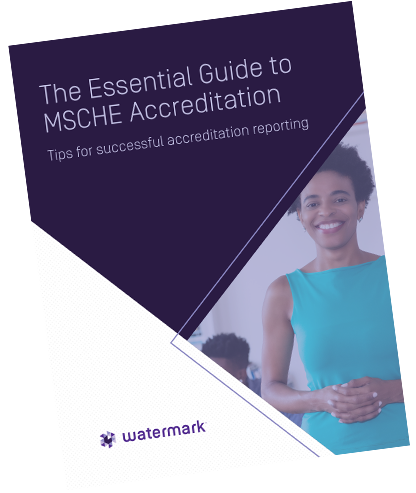The Middle States Commission on Higher Education (MSCHE) is a recognized, independent accreditor of the United States Department of Education (USDE). Its parent organization, the Middle States Association of Colleges and Schools, oversees its operation. Middle states accreditation includes evaluations of all aspects of a higher education institution. MSCHE takes a holistic approach to ensure institutions meet their standards.
If you want to gain or reaffirm your MSCHE accreditation, it’s essential to understand the checks and balances involved. What goes into accreditation preparation? Is it worth it? What are the benefits? While the process can be time-consuming and complex, using the right tools can simplify it. With technology, you can enhance the value of your data and provide access to many lasting benefits.
In this ebook, we’ll take a deep dive into MSCHE standards and outline how you can use technology to interpret data and support the documentation you need for accreditation.


Before institutions can gain MSCHE accreditation, they must acquire candidacy for accreditation status. The process includes many steps, including achieving and sustaining the commission’s Standards for Accreditation and Requirements of Affiliation. You must also abide by MSCHE policies and procedures, as well as any federal regulatory requirements. The application and candidacy review cycle includes three phases:
Application and pre-application submission deadlines are on the first day of February, April, June, August, and October.
To be eligible or achieve MSCHE accreditations, you must meet complex standards. If you’re applying for accreditation, it’s best to understand each standard in detail, but a general overview includes:
You must conduct regular evaluations to ensure you’re consistently complying with these standards to maintain accreditation.
MSCHE accreditation is an undeniably complex process. You must examine your institution’s educational quality and viability, gathering indisputable evidence that it has the qualities accreditors expect from high-performing institutions. Specifically, you should demonstrate these qualities:
The MSCHE preparation process can have lasting implications for your institution. Once the process is complete, you’ll have a detailed map of continuous improvement, including procedures for obtaining continuous feedback for each program or your entire institution. As faculty prepare, they also learn valuable skills that can change how they express their impact.
If the MSCHE has previously granted your institution accreditation, you need to continue demonstrating your quality and effectiveness through reaffirmation. Reaffirmation requires you to prove your compliance with:
Some of the benefits of the accreditation process include:
The accreditation process helps you adopt a posture of continuous improvement throughout your academic programs. Achieving accreditation requires various degree programs and encourages you to develop comprehensive pathways to student success. It ensures that programs align with industry standards and workforce needs. Overall, accreditation enhances the student experience during and after degree completion.
Students who graduate from accredited institutions are also more likely to be better prepared for their careers. Accreditation acts as a seal of approval, and employers know that graduates from these institutions have received the highest quality education.
The fundamental role of higher education institutions is to provide students with the highest quality education. Agility and continuous improvement are the foundations of achieving this goal. The accreditation process shifts your focus to accommodate growth and collaboration.
While you’re gathering the data and collaborating across your institution, you strengthen the bonds within your faculty and set up a system to drive continuous improvement. Once accredited, you continually monitor and assess your data, pinpointing strengths and weaknesses in various areas. You can use data to make real-time adjustments and demonstrate your commitment.
When you embark on your accreditation journey, the following tips can streamline and strengthen the process:
The MSCHE values institutions that fuel discovery and progress and promote quality through honest reflection. Institutional mission statements should be specific, reflecting your institution’s schools and departments.
Your institution should be cohesive, with every element flowing from and supporting your mission statement. Without a clear mission statement, your institution has nothing concrete to aim for, and your efforts may be in vain. Evaluate your latest mission statement and establish whether it accurately reflects the institution’s current purpose.
It should act like a contract with students, faculty, stakeholders, and the local community, outlining the goals your institution aims to accomplish in the long term. An effective mission statement has enough detail to lead your institution across academic and administrative departments. Each unit should refine its mission statement in line with the overall one.
Mission statements change with your organization as you achieve goals and adapt to changing student needs. When your mission statement evolves, it’s essential to ensure everyone knows about the changes. Store your mission statement in a unified location so everyone has access. When everyone in your institution can access the document, they can provide input and ensure that their actions align with your goals. Archive your previous mission statements for reference.
Like students, faculty have goals for career advancement, and many aim for tenured professorships at their institutions. To do so, they must meet your own stringent requirements. These elements reflect expertise and specialization, professional development, credibility, and research. As your faculty collects and documents their achievements, they create masses of information you can use to achieve accreditation.
Faculty accreditation documentation should demonstrate their impact on the institution and the role they play in achieving its mission. The process begins with faculty showcasing that their courses have a positive impact on each student’s grades, engagement, and other key performance indicators (KPIs).
When compiling faculty data, consider any additional qualifications they may have. Have they worked in a position that corresponds to their teaching? A marketing professor could have worked for an influential agency, which you should include in their records.
Identifying and correcting the missing pieces in faculty activity reporting has been challenging in the past. With the right dataset, the process becomes much simpler. Use purpose-built software solutions to capture the necessary information in the correct format for accreditation compliance.
As your institution works to achieve its mission, your Office of Institutional Planning and Effectiveness will become integral to the result. They are focused on improving your institution through ongoing evaluation. Their ability to quantify student learning outcomes is more vital than ever in a changing higher education landscape. This team must detect trends and devise solutions as the environment evolves.
When your Office of Institutional Planning and Effectiveness operates effectively, you can expect help with:
With the right solutions, your office can measure data, identify trends, envision results, and make the necessary changes to improve every assessment.
Documenting student achievement has a positive impact outside of accreditation preparation. Your reputation for educational quality matters to prospective students, and a detailed reporting system can differentiate your institution from competitors.
Insights into student achievement also guide how your institution allocates resources, time, and money. In simple terms, accurate student achievement reporting is crucial to your bottom line. It consists of the following elements:
A robust course evaluation solution simplifies capturing indirect measures while integrating seamlessly with your learning management system (LMS). It reminds your students to complete surveys, boosts responses, and gathers meaningful results. You can use survey data to reveal various trends. Combine them with direct success measurements, and you have the complete picture of student performance alongside learning outcomes. You have all the data to deliver continuous improvement.
The idea of these measurements is to report the results to stakeholders. Analyze the results to determine whether you’re meeting your outcomes goals. In areas where you fall short, you can take action toward continuous improvement.
Like many other accreditors, the MSCHE requires institutions to undergo a self-study process, which culminates in a detailed written report. Your report should cover every aspect of educational quality, detail your success in meeting your mission, and showcase evidence of compliance with MSCHE accreditation requirements. The MSCHE expects assessment information to be incorporated effectively to identify your strengths and challenges, all backed by extensive evidence.
Your self-study report should include:
Compiling data in a rush comes with significant challenges. In contrast, you can use specialized templates to delegate responsibilities across teams. Those overseeing the self-study can access ongoing comments and documentation on role assignments across all collaborators. Technology gives you the transparency to track your progress toward accreditation holistically and embed documentation throughout the corresponding sections of your report.
In essence, accreditation is about using your data to demonstrate your institution’s impact on students, faculty, and the community. Many institutions choose to get ready for accreditation, but when you stay ready, the process is smoother, more accurate, and reveals actionable insights you can use to drive continuous improvement. Access to innovative technology gives you constant access to your data so you can make improvements in real time and drive your institution toward accreditation.
Watermark offers a complete Educational Impact Suite — solutions designed for higher education, simplifying data connection and reporting. We offer accreditation support and insightful evidence, freeing up your time for more detailed analysis and strategic planning. Request a demo today to learn more.

See how our tools are helping clients right now, get in-depth information on topics that matter, and stay up-to-date on trends in higher ed.